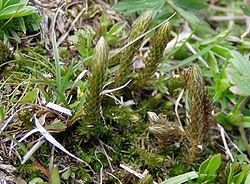Selaginella selaginoides
| Selaginella selaginoides | |
|---|---|
 |
|
| About 1600 metres above sea-level, Rax, Austria | |
| Scientific classification | |
| Kingdom: | Plantae |
| Division: | Lycopodiophyta |
| Class: | Isoetopsida |
| Order: | Selaginellales |
| Family: | Selaginellaceae |
| Genus: | Selaginella |
| Species: | S. selaginoides |
| Binomial name | |
|
Selaginella selaginoides (L.) Beauv. ex Mart. & Schrank |
|
Selaginella selaginoides is a non-flowering plant of the spikemoss genus Selaginella with a wide distribution around the Northern Hemisphere. It resembles a moss in appearance but is a vascular plant belonging to the division Lycopodiophyta. It has a number of common names including lesser clubmoss,club spikemoss,northern spikemoss, low spikemoss and prickly mountain-moss. This plant has one close relative, Selaginella deflexa, native to Hawaii. These two plants form a small clade that is sister to all other Selaginella species.
It is a small, delicate, low-growing plant. Its perennial sterile stems are short, slender and irregularly branched reaching up to 15 cm in length. They creep along the ground but usually turn upwards near the tip. They have small, pointed, triangular leaves about 1-2 mm long, each bearing a ligule on its upper surface near the base.
The plant also produces annual fertile shoots. They are more robust than the sterile stems and stand erect. They are usually 3-6 cm tall and 4-6 mm across but can grow to 10cm when conditions are favourable. Their leaves are slightly longer than those of the sterile stems and are spirally arranged around the stem, pointing upwards.
The fertile shoots bear stout, yellowish cones which are only slightly differentiated from the branch. The cones usually bear two kinds of sporangia: lobed megasporangia in the lower part of the cone which produce megaspores and simple microsporangia in the upper part which produce many tiny microspores.
It has a near-circumpolar distribution in the northern hemisphere, including northern parts of Europe, Asia and North America including Greenland, Iceland and the Faroe Islands. In Europe it occurs south to the Pyrenees, Apennines and Caucasus. In Asia it reaches Japan while in North America it occurs south as far as Nevada, Wisconsin, Michigan and Maine.
...
Wikipedia
